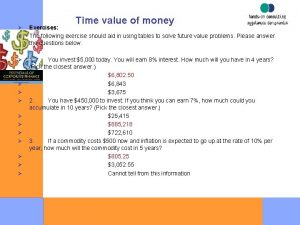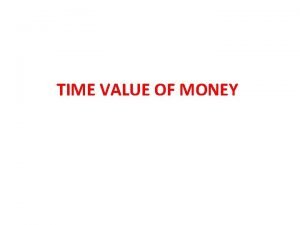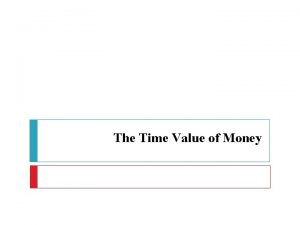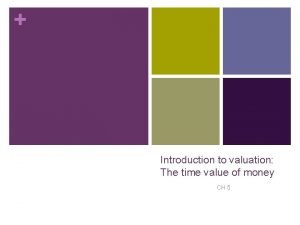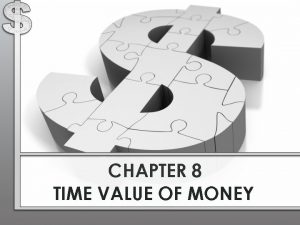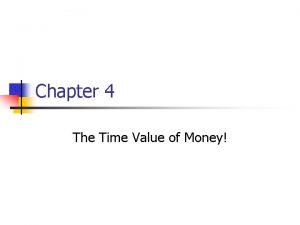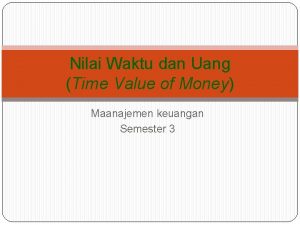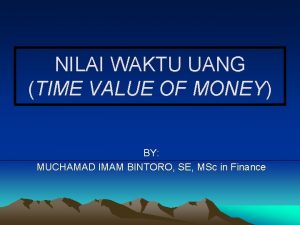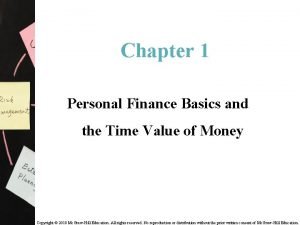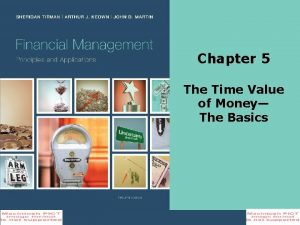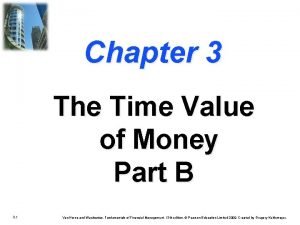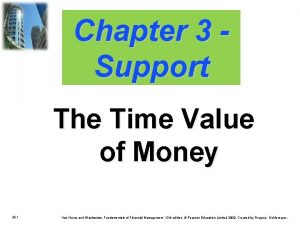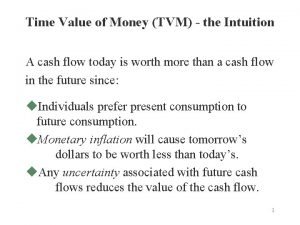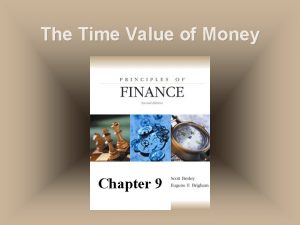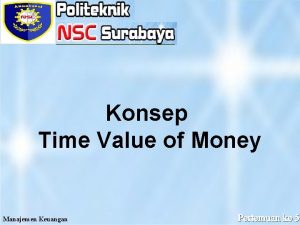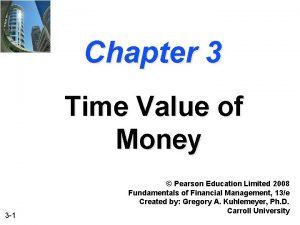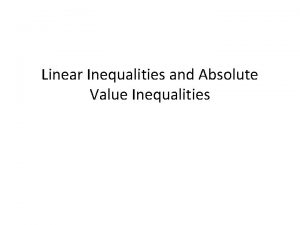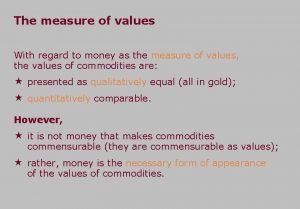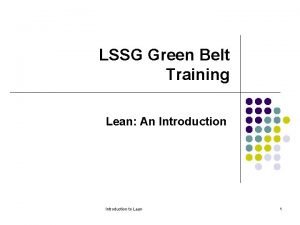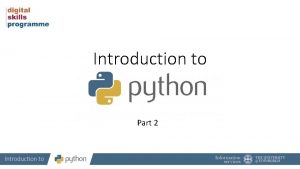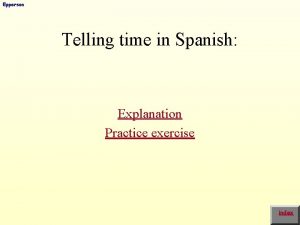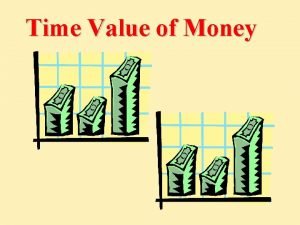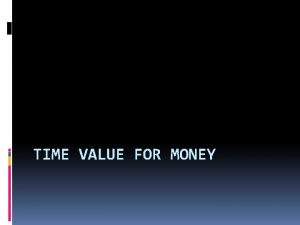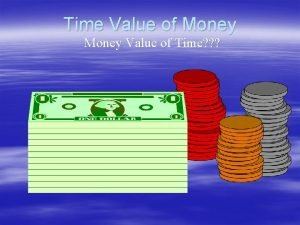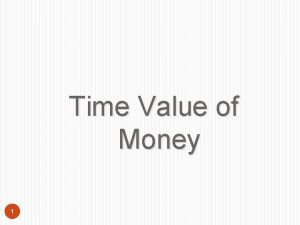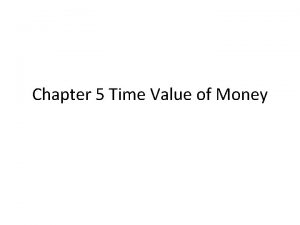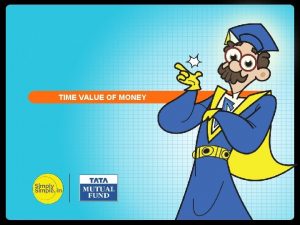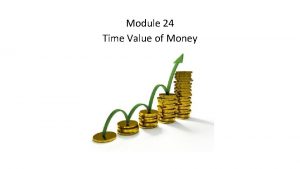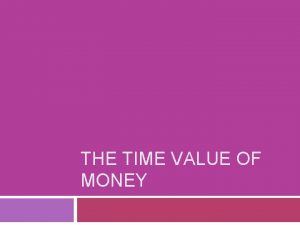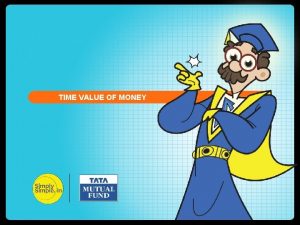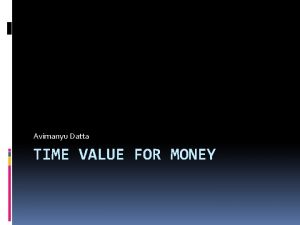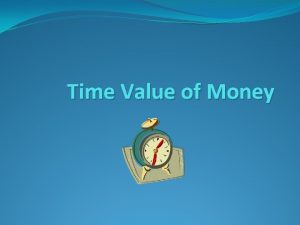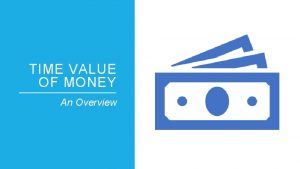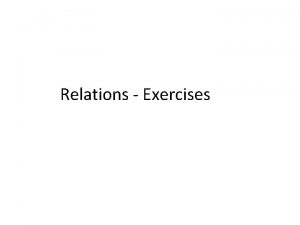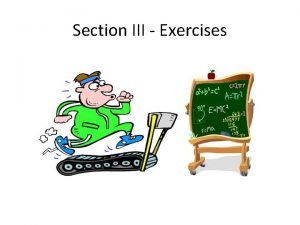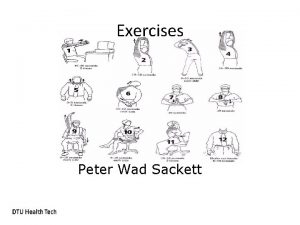Time value of money Exercises The following exercise

























































- Slides: 57

Ø Ø Ø Ø Time value of money Exercises: The following exercise should aid in using tables to solve future value problems. Please answer the questions below. 1. You invest $5, 000 today. You will earn 8% interest. How much will you have in 4 years? (Pick the closest answer. ) $6, 802. 50 $6, 843 $3, 675 2. You have $450, 000 to invest. If you think you can earn 7%, how much could you accumulate in 10 years? (Pick the closest answer. ) $25, 415 $885, 218 $722, 610 3. If a commodity costs $500 now and inflation is expected to go up at the rate of 10% per year, how much will the commodity cost in 5 years? $805. 25 $3, 052. 55 Cannot tell from this information

Discounted Cash Flow Valuation Chapter 5

Key Concepts and Skills • Be able to compute the future value of multiple • • • cash flows Be able to compute the present value of multiple cash flows Be able to compute loan payments Be able to find the interest rate on a loan Understand how loans are amortised or paid off Understand how interest rates are quoted Copyright 2007 Mc. Graw-Hill Australia Pty Ltd PPTs t/a Essentials of Corporate Finance by Ross, Trayler, Bird, Westerfield & Jordan Slides prepared by Rowan Trayler 5 -2

Chapter Outline • Future and Present Values of Multiple Cash Flows • Valuing Level Cash Flows: Annuities and Perpetuities • Comparing Rates: The Effect of Compounding Periods • Loan Types and Loan Amortisation Copyright 2007 Mc. Graw-Hill Australia Pty Ltd PPTs t/a Essentials of Corporate Finance by Ross, Trayler, Bird, Westerfield & Jordan Slides prepared by Rowan Trayler 5 -3

Multiple Cash Flows – FV Example 5. 1 • • • You think you will be able to deposit $4, 000 at the end of each of the next three years in a bank account paying 8 percent interest. You currently have $7, 000 in the account. How much will you have in three years? In four years? Find the value at year 3 of each cash flow and add them together. – Today (year 0): FV = 7000(1. 08)3 = $8, 817. 98 – Year 1: FV = 4, 000(1. 08)2 = $4, 665. 60 – Year 2: FV = 4, 000(1. 08) = $4, 320 – Year 3: value = $4, 000 – Total value in 3 years = 8817. 98 + 4665. 60 + 4320 + 4000 = $21, 803. 58 Value at year 4 = 21, 803. 58(1. 08) = $23, 547. 87 Copyright 2007 Mc. Graw-Hill Australia Pty Ltd PPTs t/a Essentials of Corporate Finance by Ross, Trayler, Bird, Westerfield & Jordan Slides prepared by Rowan Trayler 5 -4

Multiple Cash Flows – FV Example 2 • Suppose you invest $500 in a investment fund today and $600 in one year. If the fund pays 9% annually, how much will you have in two years? – FV = 500(1. 09)2 + 600(1. 09) = $1248. 05 Copyright 2007 Mc. Graw-Hill Australia Pty Ltd PPTs t/a Essentials of Corporate Finance by Ross, Trayler, Bird, Westerfield & Jordan Slides prepared by Rowan Trayler 5 -5

Example 2 Continued • How much will you have in 5 years if you make no further deposits? • First way: – FV = 500(1. 09)5 + 600(1. 09)4 = $1616. 26 • Second way – use value at year 2: – FV = 1248. 05(1. 09)3 = $1616. 26 Copyright 2007 Mc. Graw-Hill Australia Pty Ltd PPTs t/a Essentials of Corporate Finance by Ross, Trayler, Bird, Westerfield & Jordan Slides prepared by Rowan Trayler 5 -6

Multiple Cash Flows – FV Example 3 • Suppose you plan to deposit $100 into an account in one year and $300 into the account in three years. How much will be in the account in five years if the interest rate is 8%? – FV = 100(1. 08)4 + 300(1. 08)2 = 136. 05 + 349. 92 = $485. 97 Copyright 2007 Mc. Graw-Hill Australia Pty Ltd PPTs t/a Essentials of Corporate Finance by Ross, Trayler, Bird, Westerfield & Jordan Slides prepared by Rowan Trayler 5 -7

Example 3 Timeline 0 1 100 2 3 4 5 300 136. 05 349. 92 $485. 97 Copyright 2007 Mc. Graw-Hill Australia Pty Ltd PPTs t/a Essentials of Corporate Finance by Ross, Trayler, Bird, Westerfield & Jordan Slides prepared by Rowan Trayler 5 -8

Multiple Cash Flows – Present Value Example 5. 3 • You are offered an investment that will pay you $200 in one year, $400 the next year, $600 the next year, and $800 at the end of the fourth year. You can earn 12 percent on very similar investments. What is the most you should pay for this one? • Find the PV of each cash flow and add them – – – Year 1 CF: 200 / (1. 12)1 = 178. 57 Year 2 CF: 400 / (1. 12)2 = 318. 88 Year 3 CF: 600 / (1. 12)3 = 427. 07 Year 4 CF: 800 / (1. 12)4 = 508. 41 Total PV = 178. 57 + 318. 88 + 427. 07 + 508. 41 = 1432. 93 Copyright 2007 Mc. Graw-Hill Australia Pty Ltd PPTs t/a Essentials of Corporate Finance by Ross, Trayler, Bird, Westerfield & Jordan Slides prepared by Rowan Trayler 5 -9

Example 5. 3 Timeline 0 1 200 2 3 4 400 600 800 178. 57 318. 88 427. 07 508. 41 $1432. 93 Copyright 2007 Mc. Graw-Hill Australia Pty Ltd PPTs t/a Essentials of Corporate Finance by Ross, Trayler, Bird, Westerfield & Jordan Slides prepared by Rowan Trayler 5 -10

Multiple Cash Flows – PV Another Example • You are considering an investment that will pay you $1000 in one year, $2000 in two years and $3000 in three years. If you want to earn 10% on your money, how much would you be willing to pay? PV = 1000 / (1. 1)1 = $909. 09 – PV = 2000 / (1. 1)2 = $1652. 89 – PV = 3000 / (1. 1)3 = $2253. 94 – PV = 909. 09 + 1652. 89 + 2253. 94 = $4815. 93 – Copyright 2007 Mc. Graw-Hill Australia Pty Ltd PPTs t/a Essentials of Corporate Finance by Ross, Trayler, Bird, Westerfield & Jordan Slides prepared by Rowan Trayler 5 -11

Decisions, Decisions • Your broker calls you and tells you that he has this great investment opportunity. If you invest $100 today, you will receive $40 in one year and $75 in two years. If you require a 15% return on investments of this risk, should you take the investment? – Use the CF keys to compute the value of the investment < < – CF; CF 0 = 0; C 01 = 40; F 01 = 1; C 02 = 75; F 02 = 1 NPV; I = 15; CPT NPV = $91. 49 No – the broker is charging more than you would be willing to pay Copyright 2007 Mc. Graw-Hill Australia Pty Ltd PPTs t/a Essentials of Corporate Finance by Ross, Trayler, Bird, Westerfield & Jordan Slides prepared by Rowan Trayler 5 -13

Saving for Retirement • You are offered the opportunity to put some money away for retirement. You will receive five annual payments of $25, 000 each beginning in 40 years. How much would you be willing to invest today if you desire an interest rate of 12%? – Use cash flow keys: < CF; CF 0 = 0; C 01 = 0; F 01 = 39; C 02 = 25000; F 02 = 5; NPV; I = 12; CPT NPV = $1084. 71 Copyright 2007 Mc. Graw-Hill Australia Pty Ltd PPTs t/a Essentials of Corporate Finance by Ross, Trayler, Bird, Westerfield & Jordan Slides prepared by Rowan Trayler 5 -14

Saving for Retirement Timeline 0 1 2 … 39 40 41 42 43 44 0 0 0 … 0 25 K 25 K 25 K Notice that the year 0 cash flow = 0 (CF 0 = 0) The cash flows years 1 – 39 are 0 (C 01 = 0; F 01 = 39 The cash flows years 40 – 44 are 25, 000 (C 02 = 25, 000; F 02 = 5) Copyright 2007 Mc. Graw-Hill Australia Pty Ltd PPTs t/a Essentials of Corporate Finance by Ross, Trayler, Bird, Westerfield & Jordan Slides prepared by Rowan Trayler 5 -15

Quick Quiz: Part 1 • Suppose you are looking at the following possible cash flows: Year 1 CF = $100; Years 2 and 3 CFs = $200; Years 4 and 5 CFs = $300. The required discount rate is 7% • What is the value of the cash flows at year 5? • What is the value of the cash flows today? • What is the value of the cash flows at year 3? Copyright 2007 Mc. Graw-Hill Australia Pty Ltd PPTs t/a Essentials of Corporate Finance by Ross, Trayler, Bird, Westerfield & Jordan Slides prepared by Rowan Trayler 5 -16

Annuities and Perpetuities Defined • Annuity – finite series of equal payments that occur at regular intervals If the first payment occurs at the end of the period, it is called an ordinary annuity – If the first payment occurs at the beginning of the period, it is called an annuity due – • Perpetuity – infinite series of equal payments Copyright 2007 Mc. Graw-Hill Australia Pty Ltd PPTs t/a Essentials of Corporate Finance by Ross, Trayler, Bird, Westerfield & Jordan Slides prepared by Rowan Trayler 5 -17

Annuities and Perpetuities – Basic Formulas • Perpetuity: PV = C/r • Annuities: Copyright 2007 Mc. Graw-Hill Australia Pty Ltd PPTs t/a Essentials of Corporate Finance by Ross, Trayler, Bird, Westerfield & Jordan Slides prepared by Rowan Trayler 5 -18

Annuities and the Calculator • You can use the PMT key on the calculator for the equal payment • The sign convention still holds • Ordinary annuity versus annuity due You can switch your calculator between the two types by using the 2 nd BGN 2 nd Set on the TI BA-II Plus – If you see “BGN” or “Begin” in the display of your calculator, you have it set for an annuity due – Most problems are ordinary annuities – Copyright 2007 Mc. Graw-Hill Australia Pty Ltd PPTs t/a Essentials of Corporate Finance by Ross, Trayler, Bird, Westerfield & Jordan Slides prepared by Rowan Trayler 5 -19

Annuity – Example 5. 5 • After carefully going over your budget, you have determined you can afford to pay $632 per month towards a new sports car. You call up your local bank and find out that the going rate is 1 percent per month for 48 months. How much can you borrow? • You borrow money TODAY so you need to compute the present value. – 48 N; 1 I/Y; -632 PMT; CPT PV = $23, 999. 54 ($24, 000) • Formula: Copyright 2007 Mc. Graw-Hill Australia Pty Ltd PPTs t/a Essentials of Corporate Finance by Ross, Trayler, Bird, Westerfield & Jordan Slides prepared by Rowan Trayler 5 -20

Annuity – Sweepstakes Example • Suppose you win the Publishers Clearinghouse $10 million sweepstakes. The money is paid in equal annual instalments of $333, 333. 33 over 30 years. If the appropriate discount rate is 5%, how much is the sweepstakes actually worth today? – PV = 333, 333. 33[1 – 1/1. 0530] /. 05 = $5, 124, 150. 29 Copyright 2007 Mc. Graw-Hill Australia Pty Ltd PPTs t/a Essentials of Corporate Finance by Ross, Trayler, Bird, Westerfield & Jordan Slides prepared by Rowan Trayler 5 -21

Buying a House • You are ready to buy a house and you have a $20, 000 deposit and legal fees. Legal fees are estimated to be 4% of the loan value. You have an annual salary of $36, 000 and the bank is willing to allow your monthly mortgage payment to be equal to 28% of your monthly income. The interest rate on the loan is 6% per year with monthly compounding (. 5% per month) for a 30 -year fixed rate loan. How much money will the bank loan you? How much can you offer for the house? Copyright 2007 Mc. Graw-Hill Australia Pty Ltd PPTs t/a Essentials of Corporate Finance by Ross, Trayler, Bird, Westerfield & Jordan Slides prepared by Rowan Trayler 5 -22

Buying a House – Continued • Bank loan Monthly income = 36, 000 / 12 = $3, 000 – Maximum payment =. 28(3, 000) = $840 – PV = 840[1 – 1/1. 005360] /. 005 = $140, 105 – • Total Price Legal fees =. 04(140, 105) = $5, 604 – Deposit = 20, 000 – 5604 = $14, 396 – Total Price = 140, 105 + 14, 396 = $154, 501 – Copyright 2007 Mc. Graw-Hill Australia Pty Ltd PPTs t/a Essentials of Corporate Finance by Ross, Trayler, Bird, Westerfield & Jordan Slides prepared by Rowan Trayler 5 -23

Quick Quiz: Part 2 • You know the payment amount for a loan and you want to know how much was borrowed. Do you compute a present value or a future value? • You want to receive $5000 per month in retirement. If you can earn. 75% per month and you expect to need the income for 25 years, how much do you need to have in your account at retirement? Copyright 2007 Mc. Graw-Hill Australia Pty Ltd PPTs t/a Essentials of Corporate Finance by Ross, Trayler, Bird, Westerfield & Jordan Slides prepared by Rowan Trayler 5 -25

Finding the Payment • Suppose you want to borrow $20, 000 for a new car. You can borrow at 8% per year, compounded monthly (8/12 =. 66667% per month). If you take a 4 year loan, what is your monthly payment? 20, 000 = C[1 – 1 / 1. 006666748] /. 0066667 – C = $488. 26 – Copyright 2007 Mc. Graw-Hill Australia Pty Ltd PPTs t/a Essentials of Corporate Finance by Ross, Trayler, Bird, Westerfield & Jordan Slides prepared by Rowan Trayler 5 -26

Finding the Number of Payments – Example 5. 6 • • • You ran a little short on your spring break vacation, so you put $1, 000 on your credit card. You can only afford to make the minimum payment of $20 per month. The interest rate on the credit card is 1. 5 percent per month. How long will you need to pay off the $1, 000? Start with the equation and remember your logs – 1000 = 20(1 – 1/1. 015 t) /. 015 –. 75 = 1 – 1 / 1. 015 t =. 25 – 1 /. 25 = 1. 015 t – t = ln(1/. 25) / ln(1. 015) = 93. 111 months = 7. 75 years And this is only if you don’t charge anything more on the card! Copyright 2007 Mc. Graw-Hill Australia Pty Ltd PPTs t/a Essentials of Corporate Finance by Ross, Trayler, Bird, Westerfield & Jordan Slides prepared by Rowan Trayler 5 -28

Finding the Number of Payments – Another Example • Suppose you borrow $2000 at 5% and you are going to make annual payments of $734. 42. How long before you pay off the loan? – – – 2000 = 734. 42(1 – 1/1. 05 t) /. 05. 136161869 = 1 – 1/1. 05 t =. 863838131 1. 157624287 = 1. 05 t t = ln(1. 157624287)/ln(1. 05) = 3 years Copyright 2007 Mc. Graw-Hill Australia Pty Ltd PPTs t/a Essentials of Corporate Finance by Ross, Trayler, Bird, Westerfield & Jordan Slides prepared by Rowan Trayler 5 -29

Finding the Rate • Suppose you borrow $10, 000 from your parents to buy a car. You agree to pay $207. 58 per month for 60 months. What is the monthly interest rate? – – – Sign convention matters!!! 60 N 10, 000 PV -207. 58 PMT CPT I/Y =. 75% Copyright 2007 Mc. Graw-Hill Australia Pty Ltd PPTs t/a Essentials of Corporate Finance by Ross, Trayler, Bird, Westerfield & Jordan Slides prepared by Rowan Trayler 5 -30

Annuity – Finding the Rate Without a Financial Calculator • Trial and Error Process – Choose an interest rate and compute the PV of the payments based on this rate – Compare the computed PV with the actual loan amount – If the computed PV > loan amount, then the interest rate is too low – If the computed PV < loan amount, then the interest rate is too high – Adjust the rate and repeat the process until the computed PV and the loan amount are equal Copyright 2007 Mc. Graw-Hill Australia Pty Ltd PPTs t/a Essentials of Corporate Finance by Ross, Trayler, Bird, Westerfield & Jordan Slides prepared by Rowan Trayler 5 -31

Quick Quiz: Part 3 • • • You want to receive $5000 per month for the next 5 years. How much would you need to deposit today if you can earn. 75% per month? What monthly rate would you need to earn if you only have $200, 000 to deposit? Suppose you have $200, 000 to deposit and can earn. 75% per month – How many months could you receive the $5000 payment? – How much could you receive every month for 5 years? Copyright 2007 Mc. Graw-Hill Australia Pty Ltd PPTs t/a Essentials of Corporate Finance by Ross, Trayler, Bird, Westerfield & Jordan Slides prepared by Rowan Trayler 5 -32

Future Values for Annuities • Suppose you begin saving for your retirement by depositing $2000 per year in a superannuation fund. If the interest rate is 7. 5%, how much will you have in 40 years? – FV = 2000(1. 07540 – 1)/. 075 = $454, 513. 04 Copyright 2007 Mc. Graw-Hill Australia Pty Ltd PPTs t/a Essentials of Corporate Finance by Ross, Trayler, Bird, Westerfield & Jordan Slides prepared by Rowan Trayler 5 -33

Annuity Due • You are saving for a new house and you put $10, 000 per year in an account paying 8%. The first payment is made today. How much will you have at the end of 3 years? – FV = 10, 000[(1. 083 – 1) /. 08](1. 08) = $35, 061. 12 Copyright 2007 Mc. Graw-Hill Australia Pty Ltd PPTs t/a Essentials of Corporate Finance by Ross, Trayler, Bird, Westerfield & Jordan Slides prepared by Rowan Trayler 5 -34

Annuity Due Timeline 0 $10, 000 1 $10, 000 2 3 $10, 000 $32, 464 $35, 061. 12 Copyright 2007 Mc. Graw-Hill Australia Pty Ltd PPTs t/a Essentials of Corporate Finance by Ross, Trayler, Bird, Westerfield & Jordan Slides prepared by Rowan Trayler 5 -35

Perpetuity – Example 5. 7 • Perpetuity formula: PV = C/r • Current required return: 40 = 1/r – r =. 025 or 2. 5% per quarter – • Dividend for new preferred: 100 = C/. 025 – C = $2. 50 per quarter – Copyright 2007 Mc. Graw-Hill Australia Pty Ltd PPTs t/a Essentials of Corporate Finance by Ross, Trayler, Bird, Westerfield & Jordan Slides prepared by Rowan Trayler 5 -36

Table 5. 2 Copyright 2007 Mc. Graw-Hill Australia Pty Ltd PPTs t/a Essentials of Corporate Finance by Ross, Trayler, Bird, Westerfield & Jordan Slides prepared by Rowan Trayler 5 -37

Quick Quiz: Part 4 • • • You want to have $1 million to use for retirement in 35 years. If you can earn 1% per month, how much do you need to deposit on a monthly basis if the first payment is made in one month? What if the first payment is made today? You are considering preference shares that pay a quarterly dividend of $1. 50. If your desired return is 3% per quarter, how much would you be willing to pay? Copyright 2007 Mc. Graw-Hill Australia Pty Ltd PPTs t/a Essentials of Corporate Finance by Ross, Trayler, Bird, Westerfield & Jordan Slides prepared by Rowan Trayler 5 -38

Effective Annual Rate (EAR) • • This is the actual rate paid (or received) after accounting for compounding that occurs during the year If you want to compare two alternative investments with different compounding periods you need to compute the EAR and use that for comparison Copyright 2007 Mc. Graw-Hill Australia Pty Ltd PPTs t/a Essentials of Corporate Finance by Ross, Trayler, Bird, Westerfield & Jordan Slides prepared by Rowan Trayler 5 -39

Annual Percentage Rate • This is the annual rate that is quoted by law • By definition APR = period rate times the number of periods per year • Consequently, to get the period rate we rearrange the APR equation: – Period rate = APR/number of periods per year • You should NEVER divide the effective rate by the number of periods per year – it will NOT give you the period rate Copyright 2007 Mc. Graw-Hill Australia Pty Ltd PPTs t/a Essentials of Corporate Finance by Ross, Trayler, Bird, Westerfield & Jordan Slides prepared by Rowan Trayler 5 -40

Computing APRs • • • What is the APR if the monthly rate is. 5%? –. 5(12) = 6% What is the APR if the semiannual rate is. 5%? –. 5(2) = 1% What is the monthly rate if the APR is 12% with monthly compounding? – 12 / 12 = 1% – Can you divide the above APR by 2 to get the semiannual rate? NO!!! You need an APR based on semiannual compounding to find the semiannual rate Copyright 2007 Mc. Graw-Hill Australia Pty Ltd PPTs t/a Essentials of Corporate Finance by Ross, Trayler, Bird, Westerfield & Jordan Slides prepared by Rowan Trayler 5 -41

Things to Remember • • You ALWAYS need to make sure that the interest rate and the time period match – If you are looking at annual periods, you need an annual rate – If you are looking at monthly periods, you need a monthly rate If you have an APR based on monthly compounding, you have to use monthly periods for lump sums, or adjust the interest rate appropriately if you have payments other than monthly Copyright 2007 Mc. Graw-Hill Australia Pty Ltd PPTs t/a Essentials of Corporate Finance by Ross, Trayler, Bird, Westerfield & Jordan Slides prepared by Rowan Trayler 5 -42

Computing EARs – Example • Suppose you can earn 1% per month on $1 invested today. – What is the APR? 1(12) = 12% – How much are you effectively earning? < < • FV = 1(1. 01)12 = 1. 1268 Rate = (1. 1268 – 1) / 1 =. 1268 = 12. 68% Suppose if you put it in another account, you earn 3% per quarter. – What is the APR? 3(4) = 12% – How much are you effectively earning? < < FV = 1(1. 03)4 = 1. 1255 Rate = (1. 1255 – 1) / 1 =. 1255 = 12. 55% Copyright 2007 Mc. Graw-Hill Australia Pty Ltd PPTs t/a Essentials of Corporate Finance by Ross, Trayler, Bird, Westerfield & Jordan Slides prepared by Rowan Trayler 5 -43

EAR – Formula Remember that the APR is the quoted rate Copyright 2007 Mc. Graw-Hill Australia Pty Ltd PPTs t/a Essentials of Corporate Finance by Ross, Trayler, Bird, Westerfield & Jordan Slides prepared by Rowan Trayler 5 -44

Decisions, Decisions II • You are looking at two savings accounts. One pays 5. 25%, with daily compounding. The other pays 5. 3% with semiannual compounding. Which account should you use? – First account: • – EAR = (1 +. 0525/365)365 – 1 = 5. 39% Second account: • EAR = (1 +. 053/2)2 – 1 = 5. 37% • Which account should you choose and why? Copyright 2007 Mc. Graw-Hill Australia Pty Ltd PPTs t/a Essentials of Corporate Finance by Ross, Trayler, Bird, Westerfield & Jordan Slides prepared by Rowan Trayler 5 -45

Decisions, Decisions II Continued • Let’s verify the choice. Suppose you invest $100 in each account. How much will you have in each account in one year? – First Account: < < – Daily rate =. 0525 / 365 =. 00014383562 FV = 100(1. 00014383562)365 = $105. 39 Second Account: < < Semiannual rate =. 0539 / 2 =. 0265 FV = 100(1. 0265)2 = $105. 37 • You will have more money in the first account Copyright 2007 Mc. Graw-Hill Australia Pty Ltd PPTs t/a Essentials of Corporate Finance by Ross, Trayler, Bird, Westerfield & Jordan Slides prepared by Rowan Trayler 5 -46

Computing APRs from EARs • If you have an effective rate, how can you compute the APR? Rearrange the EAR equation and you get: Copyright 2007 Mc. Graw-Hill Australia Pty Ltd PPTs t/a Essentials of Corporate Finance by Ross, Trayler, Bird, Westerfield & Jordan Slides prepared by Rowan Trayler 5 -47

APR – Example • Suppose you want to earn an effective rate of 12% and you are looking at an account that compounds on a monthly basis. What APR must they pay? Copyright 2007 Mc. Graw-Hill Australia Pty Ltd PPTs t/a Essentials of Corporate Finance by Ross, Trayler, Bird, Westerfield & Jordan Slides prepared by Rowan Trayler 5 -48

Computing Payments with APRs • Suppose you want to buy a new computer system and the store is willing to sell it to allow you to make monthly payments. The entire computer system costs $3500. The loan period is for 2 years and the interest rate is 16. 9% with monthly compounding. What is your monthly payment? – Monthly rate =. 169 / 12 =. 01408333333 – Number of months = 2(12) = 24 – 3500 = C[1 – 1 / 1. 01408333333)24] /. 01408333333 – C = $172. 88 Copyright 2007 Mc. Graw-Hill Australia Pty Ltd PPTs t/a Essentials of Corporate Finance by Ross, Trayler, Bird, Westerfield & Jordan Slides prepared by Rowan Trayler 5 -49

Future Values with Monthly Compounding • Suppose you deposit $50 a month into an account that has an APR of 9%, based on monthly compounding. How much will you have in the account in 35 years? Monthly rate =. 09 / 12 =. 0075 – Number of months = 35(12) = 420 – FV = 50[1. 0075420 – 1] /. 0075 = $147, 089. 22 – Copyright 2007 Mc. Graw-Hill Australia Pty Ltd PPTs t/a Essentials of Corporate Finance by Ross, Trayler, Bird, Westerfield & Jordan Slides prepared by Rowan Trayler 5 -50

Present Value with Daily Compounding • You need $15, 000 in 3 years for a new car. If you can deposit money into an account that pays an APR of 5. 5% based on daily compounding, how much would you need to deposit? Daily rate =. 055 / 365 =. 00015068493 – Number of days = 3(365) = 1095 – FV = 15, 000 / (1. 00015068493)1095 = $12, 718. 56 – Copyright 2007 Mc. Graw-Hill Australia Pty Ltd PPTs t/a Essentials of Corporate Finance by Ross, Trayler, Bird, Westerfield & Jordan Slides prepared by Rowan Trayler 5 -51

Quick Quiz: Part 5 • What is the definition of an APR? • What is the effective annual rate? • Which rate should you use to compare alternative investments or loans? • Which rate do you need to use in the time value of money calculations? Copyright 2007 Mc. Graw-Hill Australia Pty Ltd PPTs t/a Essentials of Corporate Finance by Ross, Trayler, Bird, Westerfield & Jordan Slides prepared by Rowan Trayler 5 -52

Pure Discount Loans – Example 5. 11 • Bank bills are excellent examples of pure discount loans. The principal amount is repaid at some future date, without any periodic interest payments. • If a bank bill promises to repay $10, 000 in 12 months and the market interest rate is 7 percent, how much will the bill sell for in the market? – PV = 10, 000 / 1. 07 = $9345. 79 Copyright 2007 Mc. Graw-Hill Australia Pty Ltd PPTs t/a Essentials of Corporate Finance by Ross, Trayler, Bird, Westerfield & Jordan Slides prepared by Rowan Trayler 5 -53

Interest Only Loan – Example • Consider a 5 -year, interest only loan with a 7% interest rate. The principal amount is $10, 000. Interest is paid annually – What would the stream of cash flows be? < < Years 1 – 4: Interest payments of. 07(10, 000) = $700 Year 5: Interest + principal = $10, 700 • This cash flow stream is similar to the cash flows on corporate bonds and we will talk about them in greater detail later Copyright 2007 Mc. Graw-Hill Australia Pty Ltd PPTs t/a Essentials of Corporate Finance by Ross, Trayler, Bird, Westerfield & Jordan Slides prepared by Rowan Trayler 5 -54

Amortised Loan with Fixed Payment – Example • Each payment covers the interest expense plus reduces principal • Consider a 4 year loan with annual payments. The interest rate is 8% and the principal amount is $5000. – What is the annual payment? • • 5000 = C[1 – 1 / 1. 084] /. 08 C = $1509. 60 Copyright 2007 Mc. Graw-Hill Australia Pty Ltd PPTs t/a Essentials of Corporate Finance by Ross, Trayler, Bird, Westerfield & Jordan Slides prepared by Rowan Trayler 5 -55

Amortisation Table – Example Year Beginning Balance Total Payment Interest Paid Principal Paid End Balance 1 5000. 00 1509. 60 400. 00 1109. 60 3890. 40 2 3890. 40 1509. 60 311. 23 1198. 37 2692. 03 3 2692. 03 1509. 60 215. 36 1294. 24 1397. 79 1509. 60 111. 82 1397. 78 . 01 6038. 40 1038. 41 4999. 99 Totals Copyright 2007 Mc. Graw-Hill Australia Pty Ltd PPTs t/a Essentials of Corporate Finance by Ross, Trayler, Bird, Westerfield & Jordan Slides prepared by Rowan Trayler 5 -56

Example: Spreadsheet Strategies • • Each payment covers the interest expense plus reduces principal Consider a 4 year loan with annual payments. The interest rate is 8% and the principal amount is $5000. – What is the annual payment? < < • 4 N 8 I/Y 5000 PV CPT PMT = -1509. 60 Double-click on the Excel icon to see the amortisation table Copyright 2007 Mc. Graw-Hill Australia Pty Ltd PPTs t/a Essentials of Corporate Finance by Ross, Trayler, Bird, Westerfield & Jordan Slides prepared by Rowan Trayler 5 -57

Example: Work the Web • • • Several web sites have calculators that will prepare amortisation tables quickly One such site is westpac. com. au Go to their web site and enter the following information into their loan calculator: – – – Loan amount = $20, 000 Term = 10 years Interest rate = 7. 625% What is the monthly payment? Using the calculator you will get $238. 71 Copyright 2007 Mc. Graw-Hill Australia Pty Ltd PPTs t/a Essentials of Corporate Finance by Ross, Trayler, Bird, Westerfield & Jordan Slides prepared by Rowan Trayler 5 -58

Quick Quiz: Part 6 • What is a pure discount loan? What is a good example of a pure discount loan? • What is an interest only loan? What is a good example of an interest only loan? • What is an amortised loan? What is a good example of an amortised loan? Copyright 2007 Mc. Graw-Hill Australia Pty Ltd PPTs t/a Essentials of Corporate Finance by Ross, Trayler, Bird, Westerfield & Jordan Slides prepared by Rowan Trayler 5 -59
 Time value of money exercise
Time value of money exercise Dana damian
Dana damian Write the following value of money in symbol
Write the following value of money in symbol Contoh soal nilai sekarang anuitas
Contoh soal nilai sekarang anuitas Objectives of time value of money
Objectives of time value of money Introduction to valuation the time value of money
Introduction to valuation the time value of money Chapter 8 time value of money answer key
Chapter 8 time value of money answer key Time value of money quiz
Time value of money quiz Faktor yang mempengaruhi time value of money
Faktor yang mempengaruhi time value of money Diskusi tentang time value of money
Diskusi tentang time value of money Personal finance basics and the time value of money
Personal finance basics and the time value of money Time value of money
Time value of money Chapter 3 time value of money problem solutions
Chapter 3 time value of money problem solutions Chapter 3 time value of money problem solutions
Chapter 3 time value of money problem solutions Time value of money
Time value of money Chapter 2 time value of money solutions
Chapter 2 time value of money solutions Pengertian time value of money
Pengertian time value of money Chapter 3 time value of money problem solutions
Chapter 3 time value of money problem solutions Contoh value creation
Contoh value creation Valley of ashes great gatsby
Valley of ashes great gatsby Money smart money match
Money smart money match Money on money multiple
Money on money multiple The great gatsby historical context
The great gatsby historical context How is daisy described in the great gatsby
How is daisy described in the great gatsby What is elapsed time
What is elapsed time Linear and absolute value inequalities
Linear and absolute value inequalities Value of money meaning
Value of money meaning How to calculate future value of money
How to calculate future value of money Present and future value of money
Present and future value of money External value of money
External value of money Assessing value for money
Assessing value for money Money as a measure of value
Money as a measure of value Exercise answer the following questions
Exercise answer the following questions Takt time exercise
Takt time exercise Is time exercise
Is time exercise Time telling exercise
Time telling exercise Hát kết hợp bộ gõ cơ thể
Hát kết hợp bộ gõ cơ thể Frameset trong html5
Frameset trong html5 Bổ thể
Bổ thể Tỉ lệ cơ thể trẻ em
Tỉ lệ cơ thể trẻ em Gấu đi như thế nào
Gấu đi như thế nào Tư thế worms-breton
Tư thế worms-breton Bài hát chúa yêu trần thế alleluia
Bài hát chúa yêu trần thế alleluia Các môn thể thao bắt đầu bằng từ đua
Các môn thể thao bắt đầu bằng từ đua Thế nào là hệ số cao nhất
Thế nào là hệ số cao nhất Các châu lục và đại dương trên thế giới
Các châu lục và đại dương trên thế giới Cong thức tính động năng
Cong thức tính động năng Trời xanh đây là của chúng ta thể thơ
Trời xanh đây là của chúng ta thể thơ Mật thư tọa độ 5x5
Mật thư tọa độ 5x5 101012 bằng
101012 bằng Phản ứng thế ankan
Phản ứng thế ankan Các châu lục và đại dương trên thế giới
Các châu lục và đại dương trên thế giới Thơ thất ngôn tứ tuyệt đường luật
Thơ thất ngôn tứ tuyệt đường luật Quá trình desamine hóa có thể tạo ra
Quá trình desamine hóa có thể tạo ra Một số thể thơ truyền thống
Một số thể thơ truyền thống Cái miệng nó xinh thế
Cái miệng nó xinh thế Vẽ hình chiếu vuông góc của vật thể sau
Vẽ hình chiếu vuông góc của vật thể sau Nguyên nhân của sự mỏi cơ sinh 8
Nguyên nhân của sự mỏi cơ sinh 8
